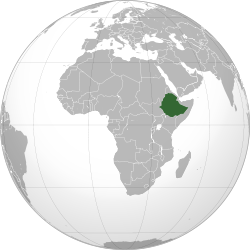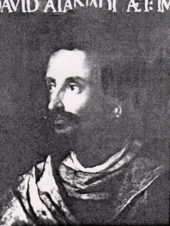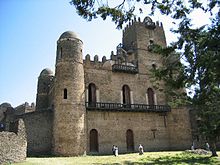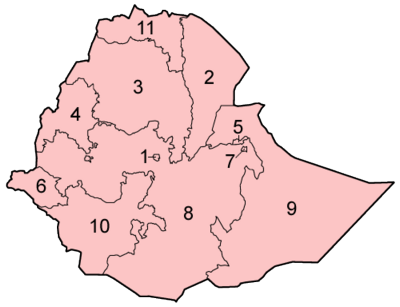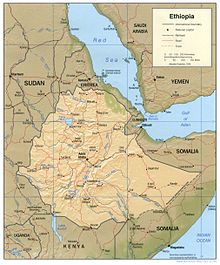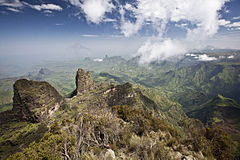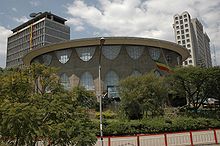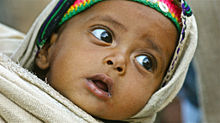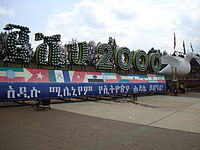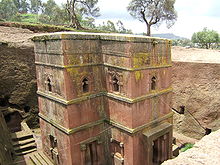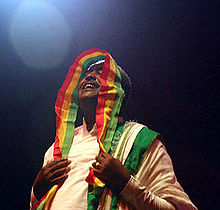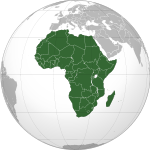- Ethiopia
-
This article is about the country. For other uses, see Ethiopia (disambiguation).
Federal Democratic Republic of Ethiopia የኢትዮጵያ ፌዴራላዊ
ዲሞክራሲያዊ ሪፐብሊክ
ye-Ītyōṗṗyā Fēdēralāwī Dīmōkrāsīyāwī Rīpeblīk

Flag Coat of arms Anthem: Wodefit Gesgeshi, Widd Innat Ityopp'ya
("March Forward, Dear Mother Ethiopia")Capital
(and largest city)Addis Ababa
9°1.8′N 38°44.4′E / 9.03°N 38.74°EOfficial language(s) Amharic, English[1][ethnologue 1][ethnologue 2] Recognised regional languages Other languages official amongst the different ethnicities and their respective regions. Ethnic groups Oromo 34.49%, Amhara 26.89%, Somali 6.20%, Tigray 6.07%; Sidama 4.01%, Gurage 2.53%, Welayta 2.31%[2][3] and around eighty other small ethnic groups. Demonym Ethiopian Government Federal parliamentary republic1 - President Girma Wolde-Giorgis - Prime Minister Meles Zenawi Establishment - Traditional date 980 BC - Current constitution 1991 Area - Total 1,104,300 km2 (27th)
426,371 sq mi- Water (%) 0.7 Population - 2011 estimate 82,101,998[4] (14th) - 2007 census 73,918,505 - Density 74/km2 (123rd)
194/sq miGDP (PPP) 2010 estimate - Total $86.123 billion[5] - Per capita $1,015[5] GDP (nominal) 2010 estimate - Total $29.717 billion[5] - Per capita $350[5] Gini (1999–00) 30 (medium) HDI (2010)  0.328 (low) (157th)
0.328 (low) (157th)Currency Birr ( ETB)Time zone EAT (UTC+3) - Summer (DST) not observed (UTC+3) Drives on the right ISO 3166 code ET Internet TLD .et Calling code 251 1 According to The Economist in its Democracy Index, Ethiopia is a "hybrid regime", with a dominant-party system led by the Ethiopian People's Revolutionary Democratic Front. 2 Rank based on 2005 population estimate by the United Nations. Ethiopia (
 /ˌiːθiˈoʊpiə/) (Ge'ez: ኢትዮጵያ ʾĪtyōṗṗyā), officially known as the Federal Democratic Republic of Ethiopia, is a country located in the Horn of Africa. It is the second-most populous nation in Africa, with over 82 million inhabitants,[4] and the tenth-largest by area, occupying 1,100,000 km2. Ethiopia is bordered by Eritrea to the north, Djibouti and Somalia to the east, Sudan and South Sudan to the west, and Kenya to the south. With its capital at Addis Ababa, it is also the most populous landlocked nation in the world.
/ˌiːθiˈoʊpiə/) (Ge'ez: ኢትዮጵያ ʾĪtyōṗṗyā), officially known as the Federal Democratic Republic of Ethiopia, is a country located in the Horn of Africa. It is the second-most populous nation in Africa, with over 82 million inhabitants,[4] and the tenth-largest by area, occupying 1,100,000 km2. Ethiopia is bordered by Eritrea to the north, Djibouti and Somalia to the east, Sudan and South Sudan to the west, and Kenya to the south. With its capital at Addis Ababa, it is also the most populous landlocked nation in the world.Ethiopia was a monarchy for most of its history, and the Ethiopian dynasty traces its roots to the 2nd century BC.[6] Ethiopia is also one of the oldest sites of human existence known to scientists today, having yielded some of humanity's oldest traces.[7] It may be the region from which Homo sapiens first set out for the Middle East and points beyond.[8][9][10] Alongside Rome, China and Persia, the Ethiopian Aksum Empire was considered one of the four great world powers of the 3rd century.[11][12][13] During the Scramble for Africa, Ethiopia was the only African country that retained its independence and one of only four African members of the League of Nations. After a brief period of Italian occupation, Ethiopia became a charter member of the United Nations. When other African nations received their independence following World War II, many of them adopted the colors of Ethiopia's flag, and Addis Ababa became the location of several international organizations focused on Africa.
Modern Ethiopia and its current borders are a result of significant territorial reduction in the north and expansion in the south toward its present borders, owing to several migrations and commercial integration as well as conquests, particularly by Emperor Menelik II and Ras Gobena. In 1974, the dynasty led by Haile Selassie was overthrown as civil wars intensified. Since then, Ethiopia has seen a variety of governmental systems. Ethiopia is one of the founding members of the Non-Aligned Movement (NAM), G-77 and the Organisation of African Unity (OAU). Today, Addis Ababa is still the headquarters of the African Union, the Pan African Chamber of Commerce (PACCI) and[14] UNECA. The country has one of the most powerful militaries in Africa and Addis Ababa is the headquarter of the continental African Standby Force (ASF). Ethiopia is one of a few African countries where an indigenous alphabet is still used.[15] Ethiopia also has its own time system and unique calendar, seven to eight years behind the Gregorian Calendar. It has the largest number of UNESCO World Heritage Sites in Africa.[16]
The country is a land of natural contrasts, with waterfalls and volcanic hot springs. Ethiopia has some of Africa's highest mountains as well as some of the world's lowest points below sea level. The largest cave in Africa is located in Ethiopia at Sof Omar. Ethiopia has one of the largest number of rivers in the world while the country's northernmost area at Dallol, Afar is the hottest place year-round anywhere on Earth. Ethiopia is a Multilingual,Multicultural and Multiethnic society of around 80 groups, with the two largest being the Oromo and the Amhara, both of which speak Afro-Asiatic languages. The country is also famous for its Olympic gold medalists (especially in distance running), rock-hewn churches in Lalibela, and as the place where the coffee bean originated. Currently, Ethiopia is the top coffee and honey-producing country in Africa, and home to the largest livestock population in Africa. The Ethiopian Aksum region was the first major empire in the world to convert to Christianity and it was one of the first countries to officially adopt Christianity as a state religion in the 4th century.[17] Ethiopia has a Christian majority and a third of the population is Muslim. Ethiopia is the site of the first hijra in Islamic history and the oldest Muslim settlement in Africa at Negash. Until the 1980s, a substantial population of Ethiopian Jews resided in Ethiopia. The country is also the spiritual homeland of the Rastafari religious movement.
Ethiopia, which has Africa's second biggest hydropower potential,[18] is the source of over 85% of the total Nile water flow and contains rich soils, but it nevertheless underwent a series of famines in the 1980s, exacerbated by adverse geopolitics and civil wars, resulting in the death of hundreds of thousands.[19] Slowly, however, the country has begun to recover, and today Ethiopia has the biggest economy in East Africa (GDP)[20] as the Ethiopian economy is also one of the fastest growing in the world. It is a regional powerhouse in the Horn and east Africa.[21][22][23][24][25] Recently, human rights abuses have been reported in Ethiopia, however under Premier Meles Zenawi the country has become a leading economic, diplomatic and political force in Africa.[26][27][28]
Contents
Names
The Greek name Αἰθιοπία (from Αἰθίοψ, Aithiops, 'an Ethiopian') appears twice in the Iliad and three times in the Odyssey.[29] The Greek historian Herodotus specifically uses it for all the lands south of Egypt,[30] including Sudan and modern Ethiopia. Pliny the Elder says the country's name comes from a son of Hephaestus (aka Vulcan) named Aethiops.[31] Similarly, in the 15th century Ge'ez Book of Aksum, the name is ascribed to a legendary individual called Ityopp'is, an extrabiblical son of Cush, son of Ham, said to have founded the city of Axum. In addition to this Cushite figure, two of the earliest Semitic kings are also said to have born the name Ityopp'is according to traditional Ethiopian kinglists. Modern European scholars beginning c. 1600[32] have considered the name to be derived from the Greek words aitho "I burn" + ops "face".[33][34]
The name Ethiopia also occurs in many translations of the Old Testament, but the Hebrew texts have Kush, which refers foremost to Nubia / Sudan.[35] In the (Greek) New Testament, however, the Greek term Aithiops, ‘an Ethiopian’, does occur,[36] referring to a servant of Candace or Kentakes, possibly an inhabitant of Meroe which was later conquered by the Kingdom of Axum. The earliest attested use of the name Ityopya in the region itself is as a name for the Kingdom of Aksum in the 4th century, in stone inscriptions of King Ezana,[37] who first Christianized the entire apparatus of the kingdom.
In English, and generally outside Ethiopia, the country was also once historically known as Abyssinia, derived from Habesh, an early Arabic form of the Ethiosemitic name "Ḥabaśāt" (unvocalized "ḤBŚT"). The modern form Habesha is the native name for the country's inhabitants (while the country has been called "Ityopp'ya"). In a few languages, Ethiopia is still referred to by names cognate with "Abyssinia," e.g., modern Arabic Al-Ḥabashah, meaning land of the Habasha people.[citation needed]
The term Habesha, strictly speaking, refers only to the Semitic-speaking groups, particularly the Amhara and Tigray-Tigrinya people who have historically dominated the country politically, as well as the Gurage and other smaller communities like the Harari of eastern Ethiopia. However, in contemporary Ethiopia, the word Habesha is sometimes used to describe all people from Ethiopians and Eritreans.[dubious ] Abyssinia can strictly refer to just the northwestern Ethiopian provinces of Amhara and Tigray, as well as central Eritrea, while it was historically used as another name for Ethiopia.[38]
History
Main article: History of EthiopiaPrehistory
East Africa, and more specifically the general area of Ethiopia, is widely considered the site of the emergence of early Homo sapiens in the Middle Paleolithic 400,000 years ago. Homo sapiens idaltu, found at site Middle Awash in Ethiopia, lived about 160,000 years ago.[39]
Antiquity
 Coins of the Axumite king Endybis, 227–235 AD. British Museum. The left one reads in Greek "AΧWMITW BACIΛEYC", "King of Axum". The right one reads in Greek: ΕΝΔΥΒΙC ΒΑCΙΛΕΥC, "King Endybis".
Coins of the Axumite king Endybis, 227–235 AD. British Museum. The left one reads in Greek "AΧWMITW BACIΛEYC", "King of Axum". The right one reads in Greek: ΕΝΔΥΒΙC ΒΑCΙΛΕΥC, "King Endybis".
Around the 8th century BC, a kingdom known as Dʿmt was established in northern Ethiopia and Eritrea. Its capital was around the current town of Yeha, situated in northern Ethiopia. Most modern historians consider this civilization to be a native African one, although Sabaean-influenced because of the latter's hegemony of the Red Sea,[40] while others view Dʿmt as the result of a mixture of Sabaeans of southern Arabia and indigenous peoples.[41] However, Ge'ez, the ancient Semitic language of Ethiopia, is now thought not to have derived from Sabaean (also South Semitic). There is evidence of a Semitic-speaking presence in Ethiopia and Eritrea at least as early as 2000 BC.[42][43] Sabaean influence is now thought to have been minor, limited to a few localities, and disappearing after a few decades or a century, perhaps representing a trading or military colony in some sort of symbiosis or military alliance with the Ethiopian civilization of Dʿmt or some other proto-Aksumite state.[44]
After the fall of Dʿmt in the 4th century BC, the plateau came to be dominated by smaller successor kingdoms, until the rise of one of these kingdoms during the 1st century BC, the Aksumite Empire, ancestor of medieval and modern Ethiopia, which was able to reunite the area.[45] The Aksumites established bases on the northern highlands of the Ethiopian Plateau, and from there expanded southward. The Persian religious figure Mani listed Aksum with Rome, Persia, and China as one of the four great powers of his time.[46]
In 316 AD, a Christian philosopher from Tyre, Meropius, embarked on a voyage of exploration along the coast of Africa. He was accompanied by, among others, two Syro-Greeks, Frumentius and his brother Aedesius. The vessel was stranded on the coast, and the natives killed all the travelers except the two brothers, who were taken to the court and given positions of trust by the monarch. They both practiced the Christian faith in private, and soon converted the queen and several other members of the royal court.
Middle Ages
The Zagwe dynasty ruled many parts of modern Ethiopia and Eritrea from approximately 1137 to 1270. The name of the dynasty is derived from the Cushitic-speaking Agaw of northern Ethiopia. From 1270 AD onwards for many centuries, the Solomonic dynasty ruled the Ethiopian Empire.
In the early 15th century, Ethiopia sought to make diplomatic contact with European kingdoms for the first time since Aksumite times. A letter from King Henry IV of England to the Emperor of Abyssinia survives.[47] In 1428, the Emperor Yeshaq sent two emissaries to Alfonso V of Aragon, who sent return emissaries who failed to complete the return trip.[48] The first continuous relations with a European country began in 1508 with Portugal under Emperor Lebna Dengel, who had just inherited the throne from his father.[49]
This proved to be an important development, for when the Empire was subjected to the attacks of the Adal General and Imam, Ahmad ibn Ibrihim al-Ghazi (called "Grañ", or "the Left-handed"), Portugal assisted the Ethiopian emperor by sending weapons and four hundred men, who helped his son Gelawdewos defeat Ahmad and re-establish his rule.[50] This Ethiopian–Adal War was also one of the first proxy wars in the region as the Ottoman Empire and Portugal took sides in the conflict. However, when Emperor Susenyos converted to Roman Catholicism in 1624, years of revolt and civil unrest followed resulting in thousands of deaths.[51] The Jesuit missionaries had offended the Orthodox faith of the local Ethiopians, and on 25 June 1632 Susenyos's son, Emperor Fasilides, declared the state religion to again be Ethiopian Orthodox Christianity, and expelled the Jesuit missionaries and other Europeans.[52][53]
Zemene Mesafint
 Emperor Yohannes IV led Ethiopian troops in the Battle of Gundet, among other campaigns.
Emperor Yohannes IV led Ethiopian troops in the Battle of Gundet, among other campaigns.
All of this contributed to Ethiopia's isolation from 1755 to 1855, a period called the Zemene Mesafint or "Age of Princes". The Emperors became figureheads, controlled by warlords like Ras Mikael Sehul of Tigray, Ras Wolde Selassie of Tigray, and by the Oromo Yejju dynasty, such as Ras Gugsa of Begemder, which later led to 17th century Oromo rule of Gondar, changing the language of the court from Amharic to Afaan Oromo.[54][55]
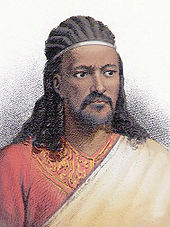 Emperor Tewodros II's rule is often placed as the beginning of modern Ethiopia, ending the decentralized Zemene Mesafint (Era of the Princes).
Emperor Tewodros II's rule is often placed as the beginning of modern Ethiopia, ending the decentralized Zemene Mesafint (Era of the Princes).
Ethiopian isolationism ended following a British mission that concluded an alliance between the two nations; however, it was not until 1855 that Ethiopia was completely united and the power in the Emperor restored, beginning with the reign of Emperor Tewodros II. Upon his ascent, despite still large centrifugal forces, he began modernizing Ethiopia and recentralizing power in the Emperor, and Ethiopia began to take part in world affairs once again.
But Tewodros suffered several rebellions inside his empire. Northern Oromo militias, Tigrayan rebellion and the constant incursion of Ottoman Empire and Egyptian forces near the Red Sea brought the weakening and the final downfall of Emperor Tewodros II, who committed suicide in 1868 after his last battle with a British expeditionary force.
After Tewodros' death, Tekle Giyorgis II was proclaimed Emperor. However, he was later defeated in the Battles of Zulawu (21 Jun 1871) and Adua (11 Jul 1871) by Dejazmach Kassai with the aid of John Kirkham, a British advisor who had trained his troops with modern weapons. Tekle Giyorgis was captured and deposed and Kassai was declared Emperor Yohannes IV on 21 January 1872. In 1875 and 1876, Turkish/Egyptian forces, accompanied by many European and American 'advisors', twice invaded Abyssinia but were initially defeated at the Battle of Gundet losing 800 men, and then following the second invasion, decisively defeated by Emperor Yohannes IV at the Battle of Gura on 7 March 1875, losing at least 3000 killed or captured.[56] From 1885 to 1889 Ethiopia joined the Mahdist War allied to Britain, Turkey and Egypt against the Sudanese Mahdist State. On 10 March 1889 Yonannes IV was killed whilst leading his army in the Battle of Gallabat (also called Battle of Metemma).
From Menelik to Adwa
Ethiopia as we currently know it began under the reign of Menelik II who was Emperor from 1889 until his death in 1913.[57] From the central province of Shoa, Menelik set off to subjugate and incorporate ‘the lands and people of the South, East and West into an empire.’[58] He did this with the help of Ras Gobena's Shewan Oromo militia, began expanding his kingdom to the south and east, expanding into areas that had not been held since the invasion of Ahmed Gragn, and other areas that had never been under his rule, resulting in the borders of Ethiopia of today.[59] At the same time there were also advances in road construction, electricity and education, development of a central taxation system, and the foundation and building of the city of Addis Ababa – which became capital of Shoa province in 1881 which Menelik then ruled as Ras, and subsequently became the new capital of Abyssinia on his accession to the throne in 1889.[60] Menelik had signed the Treaty of Wichale with Italy in May 1889 in which Italy would recognize Ethiopia’s sovereignty so long as Italy could control a small area north of Ethiopia (part of modern Eritrea).[61] In return Italy was to provide Menelik with arms and support him as emperor.[62] The Italians used the time between the signing of the treaty and its ratification by the Italian government to further expand their territorial claims. This conflict erupted in the battle of Adwa on 1 March 1896 in which Italy’s colonial forces were defeated by the Ethiopians.[63] The Great Ethiopian Famine of 1888 to 1892 cost it roughly one-third of its population.[64][65]
Haile Selassie era
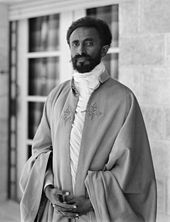 Haile Selassie's reign as emperor of Ethiopia is the best known and perhaps most influential in the nation's history. He is seen by Rastafarians as Jah incarnate.
Haile Selassie's reign as emperor of Ethiopia is the best known and perhaps most influential in the nation's history. He is seen by Rastafarians as Jah incarnate.
The early 20th century was marked by the reign of Emperor Haile Selassie I, who came to power after Iyasu V was deposed. It was he who undertook the modernization of Ethiopia, from 1916, when he was made a Ras and Regent (Inderase) for Zewditu I and became the de facto ruler of the Ethiopian Empire. Following Zewditu's death he was made Emperor on 2 November 1930.
Haile Selassie was born from parents of three Ethiopian ethnicities: the Oromo and Amhara, which are the country's two main ethnic groups, as well as the Gurage.
The independence of Ethiopia was interrupted by the Second Italo-Abyssinian War and Italian occupation (1936–1941).[66] During this time of attack, Haile Selassie appealed to the League of Nations in 1935, delivering an address that made him a worldwide figure, and the 1935 Time magazine Man of the Year.[67] Following the entry of Italy into World War II, British Empire forces, together with patriot Ethiopian fighters, liberated Ethiopia in the course of the East African Campaign in 1941. This was followed by British recognition of full sovereignty, (i.e. without any special British privileges), with the signing of the Anglo-Ethiopian Agreement in December 1944.[68] During 1942 and 1943 there was an Italian guerrilla war in Ethiopia. On 26 August 1942 Haile Selassie I issued a proclamation outlawing slavery.[69][70] Ethiopia had between two and four million slaves in early 20th century out of a total population of about eleven million.[71]
In 1952 Haile Selassie orchestrated the federation with Eritrea which he dissolved in 1962. This annexation sparked the Eritrean War of Independence. Although Haile Selassie was seen as a national hero, opinion within Ethiopia turned against him owing to the worldwide oil crisis of 1973, food shortages, uncertainty regarding the succession, border wars, and discontent in the middle class created through modernization.[72]
He played a leading role in the formation of the Organisation of African Unity (OAU) in 1963.
Haile Selassie's reign came to an end in 1974, when a Soviet-backed Marxist-Leninist military junta, the "Derg" led by Mengistu Haile Mariam, deposed him, and established a one-party communist state which was called People's Democratic Republic of Ethiopia.
Mengistu era
The ensuing regime suffered several coups, uprisings, wide-scale drought, and a huge refugee problem. In 1977, there was the Ogaden War, when Somalia captured part of the Ogaden region, but Ethiopia was able to recapture the Ogaden after receiving military aid from the USSR, Cuba, South Yemen, East Germany[73] and North Korea, including around 15,000 Cuban combat troops.
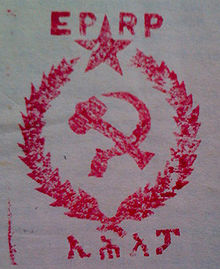 Logo of the Ethiopian People's Revolutionary Party (EPRP).
Logo of the Ethiopian People's Revolutionary Party (EPRP).
Hundreds of thousands were killed as a result of the red terror, forced deportations, or from the use of hunger as a weapon under Mengistu's rule.[72] The Red Terror was carried out in response to what the government termed "White Terror", supposedly a chain of violent events, assassinations and killings carried out by the opposition.[74] In 2006, after a trial that lasted 12 years, Ethiopia's Federal High Court in Addis Ababa found Mengistu guilty in absentia of genocide.[75]
In the beginning of 1980s, a series of famines hit Ethiopia that affected around 8 million people, leaving 1 million dead. Insurrections against Communist rule sprang up particularly in the northern regions of Tigray and Eritrea. In 1989, the Tigrayan Peoples' Liberation Front (TPLF) merged with other ethnically based opposition movements to form the Ethiopian Peoples' Revolutionary Democratic Front (EPRDF). Concurrently the Soviet Union began to retreat from building World Communism under Mikhail Gorbachev's glasnost and perestroika policies, marking a dramatic reduction in aid to Ethiopia from Socialist bloc countries. This resulted in even more economic hardship and the collapse of the military in the face of determined onslaughts by guerrilla forces in the north. The Collapse of Communism in general, and in Eastern Europe during the Revolutions of 1989, coincided with the Soviet Union stopping aid to Ethiopia altogether in 1990. The strategic outlook for Mengistu quickly deteriorated.
In May 1991, EPRDF forces advanced on Addis Ababa and the Soviet Union did not intervene to save the government side. Mengistu fled the country to asylum in Zimbabwe, where he still resides. The Transitional Government of Ethiopia, composed of an 87-member Council of Representatives and guided by a national charter that functioned as a transitional constitution, was set up. In June 1992, the Oromo Liberation Front withdrew from the government; in March 1993, members of the Southern Ethiopia Peoples' Democratic Coalition also left the government. In 1994, a new constitution was written that formed a bicameral legislature and a judicial system. The first formally multi-party election took place in May 1995 in which Meles Zenawi was elected the Prime Minister and Negasso Gidada was elected President.
Recent history
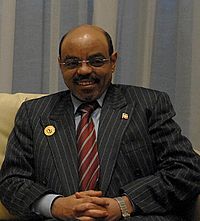 Prime Minister of Ethiopia Meles Zenawi.
Prime Minister of Ethiopia Meles Zenawi.
In 1994, a constitution was adopted that led to Ethiopia's first multi-party elections in the following year. In May 1998, a border dispute with Eritrea led to the Eritrean-Ethiopian War that lasted until June 2000 and cost both countries an estimated $1 million a day.[76] This has hurt the nation's economy, but strengthened the ruling coalition. On 15 May 2005, Ethiopia held another multiparty election, which was a highly disputed one with some opposition groups claiming fraud. Though the Carter Center approved the preelection conditions, it has expressed its dissatisfaction with postelection matters. The 2005 EU election observers continued to accuse the ruling party of vote rigging. In general, the opposition parties gained more than 200 parliamentary seats compared to the just 12 in the 2000 elections. Despite most opposition representatives joining the parliament, certain leaders of the CUD party, some of which refused to take up their parliamentary seats, were accused of inciting the post-election violence that ensued and were imprisoned. Amnesty International considered them "prisoners of conscience" and they were subsequently released.
The coalition of opposition parties and some individuals that was established in 2009 to oust at the general election in 2010 the regime of the EPRDF, Meles Zenawi’s party that has been in power since 1991, published its 65-page manifesto in Addis Ababa on October 10, 2009.
Some of the eight member parties of this Ethiopian Forum for Democratic Dialogue (FDD or Medrek in Amharic) include the Oromo Federalist Congress (organized by the Oromo Federalist Democratic Movement and the Oromo People’s Congress), the Arena Tigray (organized by former members of the ruling party TPLF), the Unity for Democracy and Justice (UDJ, whose leader is imprisoned), and the Coalition of Somali Democratic Forces.
In mid 2011, two consecutive missed rainy seasons precipitated the worst drought in East Africa seen in 60 years. Full recovery from the drought's effects are not expected until 2012, with long-term strategies by the national government in conjunction with development agencies believed to offer the most sustainable results.[77]
Politics
Main article: Politics of EthiopiaSee also: Rulers and Heads of State of Ethiopia, Foreign relations of Ethiopia, Human rights in Ethiopia, and Ethiopian National Defense ForceThe politics of Ethiopia takes place in a framework of a federal parliamentary republic, whereby the Prime Minister is the head of government. Executive power is exercised by the government. Federal legislative power is vested in both the government and the two chambers of parliament.
On the basis of Article 78 of the 1994 Ethiopian Constitution, the Judiciary is completely independent of the executive and the legislature.[78] The current realities of this provision are questioned in a report prepared by Freedom House.
According to The Economist in its Democracy Index published in late 2010, Ethiopia is an "authoritarian regime", ranking 118th out of 167 countries (with the larger number being less democratic).[79] Ethiopia has dropped 12 places on the list since 2006, and the latest report attributes the drop to the regime's crackdown on opposition activities, media and civil society before the 2010 parliamentary election, which the report argues has made Ethiopia a de facto one-party state.
Governance
The election of Ethiopia's 547-member constituent assembly was held in June 1994. This assembly adopted the constitution of the Federal Democratic Republic of Ethiopia in December 1994. The elections for Ethiopia's first popularly chosen national parliament and regional legislatures were held in May and June 1995 . Most opposition parties chose to boycott these elections. There was a landslide victory for the Ethiopian People's Revolutionary Democratic Front (EPRDF). International and non-governmental observers concluded that opposition parties would have been able to participate had they chosen to do so.
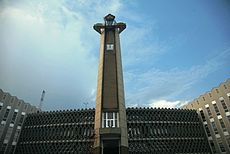 The city hall in Addis Ababa.
The city hall in Addis Ababa.
The current government of Ethiopia was installed in August 1995. The first President was Negasso Gidada. The EPRDF-led government of Prime Minister Meles Zenawi promoted a policy of ethnic federalism, devolving significant powers to regional, ethnically based authorities. Ethiopia today has nine semi-autonomous administrative regions that have the power to raise and spend their own revenues. Under the present government, some fundamental freedoms, including freedom of the press, are circumscribed.[80] Citizens have little access to media other than the state-owned networks, and most private newspapers struggle to remain open and suffer periodic harassment from the government.[80] At least 18 journalists who had written articles critical of the government were arrested following the 2005 elections on genocide and treason charges. The government uses press laws governing libel to intimidate journalists who are critical of its policies.[81]
Zenawi's government was elected in 2000 in Ethiopia's first ever multiparty elections; however, the results were heavily criticized by international observers and denounced by the opposition as fraudulent. The EPRDF also won the 2005 election returning Zenawi to power. Although the opposition vote increased in the election, both the opposition and observers from the European Union and elsewhere stated that the vote did not meet international standards for fair and free elections.[80] Ethiopian police are said to have massacred 193 protesters, mostly in the capital Addis Ababa, in the violence following the May 2005 elections in the Ethiopian police massacre.[82]
The government initiated a crackdown in the provinces as well; in Oromia state the authorities used concerns over insurgency and terrorism to use torture, imprisonment, and other repressive methods to silence critics following the election, particularly people sympathetic to the registered opposition party Oromo National Congress (ONC).[81] The government has been engaged in a conflict with rebels in the Ogaden region since 2007. The biggest opposition party in 2005 was the Coalition for Unity and Democracy (CUD). After various internal divisions, most of the CUD party leaders have established the new Unity for Democracy and Justice party led by Judge Birtukan Mideksa. A member of the country's Oromo ethnic group, Ms. Birtukan Mideksa is the first woman to lead a political party in Ethiopia.
As of 2008, the top five opposition parties are the Unity for Democracy and Justice led by Judge Birtukan Mideksa, United Ethiopian Democratic Forces led by Dr.Beyene Petros, Oromo Federalist Democratic Movement led by Dr. Bulcha Demeksa, Oromo People's Congress led by Dr. Merera Gudina, and United Ethiopian Democratic Party-Medhin Party led by Lidetu Ayalew.
Regions, zones, and districts
Before 1996, Ethiopia was divided into 13 provinces, many derived from historical regions. Ethiopia now has a tiered government system consisting of a federal government overseeing ethnically based regional countries, zones, districts (woredas), and neighborhoods (kebele).Ethiopia is divided into nine ethnically based administrative countries (kililoch, sing. kilil) and subdivided into sixty-eight zones and two chartered cities (astedader akababiwoch, sing. astedader akababi): Addis Ababa and Dire Dawa (subdivisions 1 and 5 in the map, respectively). It is further subdivided into 550 woredas and several special woredas.
The constitution assigns extensive power to regional states that can establish their own government and democracy according to the federal government's constitution. Each region has its apex regional council where members are directly elected to represent the districts and the council has legislative and executive power to direct internal affairs of the regions. Article 39 of the Ethiopian Constitution further gives every regional state the right to secede from Ethiopia. There is debate, however, as to how much of the power guaranteed in the constitution is actually given to the states. The councils implement their mandate through an executive committee and regional sectoral bureaus. Such elaborate structure of council, executive, and sectoral public institutions is replicated to the next level (woreda).
The nine regions and two chartered cities (in italics) are:
Geography
Main article: Geography of EthiopiaAt 435,071 square miles (1,126,829 km2),[83] Ethiopia is the world's 27th-largest country. It is comparable in size to Bolivia. It lies between latitudes 3° and 15°N, and longitudes 33° and 48°E.
The major portion of Ethiopia lies on the Horn of Africa, which is the easternmost part of the African landmass. Bordering Ethiopia are Sudan and South Sudan to the west, Djibouti and Eritrea to the north, Somalia to the east, and Kenya to the south. Within Ethiopia is a vast highland complex of mountains and dissected plateaus divided by the Great Rift Valley, which runs generally southwest to northeast and is surrounded by lowlands, steppes, or semi-desert. The great diversity of terrain determines wide variations in climate, soils, natural vegetation, and settlement patterns.
Ethiopia is an ecologically diverse country, ranging from the deserts along the eastern border to the tropical forests in the south to extensive Afromontane in the northern and southwestern parts. Lake Tana in the north is the source of the Blue Nile. It also has a large number of endemic species, notably the Gelada Baboon, the Walia Ibex and the Ethiopian wolf (or Simien fox). The wide range of altitude has given the country a variety of ecologically distinct areas, this has helped to encourage the evolution of endemic species in ecological isolation.
Climate
Main article: Climate of EthiopiaThe predominant climate type is tropical monsoon, with wide topographic-induced variation. The Ethiopian Highlands which cover most of the country have a climate which is generally considerably cooler than other regions at similar proximity to the Equator. Most of the country's major cities are located at elevations of around 2,000–2,500 metres (6,562–8,202 ft) above sea level, including historic capitals such as Gondar and Axum.
The modern capital Addis Ababa is situated on the foothills of Mount Entoto at an elevation of around 2,400 metres (7,874 ft), and experiences a healthy and pleasant climate year round. With fairly uniform year round temperatures, the seasons in Addis Ababa are largely defined by rainfall, with a dry season from October–February, a light rainy season from March–May, and a heavy rainy season from June–September. The average annual rainfall is around 1,200 mm (47.2 in). There are on average 7 hours of sunshine per day, meaning it is sunny for around 60% of the available time. The dry season is the sunniest time of the year, though even at the height of the rainy season in July and August there are still usually several hours per day of bright sunshine. The average annual temperature in Addis Ababa is 16 °C (60.8 °F), with daily maximum temperatures averaging 20–25 °C (68–77 °F) throughout the year, and overnight lows averaging 5–10 °C (41–50 °F).
Most major cities and tourist sites in Ethiopia lie at a similar elevation to Addis Ababa and have a comparable climate. In less elevated regions, particularly the lower lying Ethiopian xeric grasslands and shrublands in the east of the country, the climate can be significantly hotter and drier. Dallol, in the Danakil Depression in this eastern zone, has the world's highest average annual temperature of 34 °C (93.2 °F).
Environment
See also: Environmental issues in EthiopiaWildlife
Main article: Wildlife of Ethiopia The Ethiopian Wolf
The Ethiopian Wolf
Ethiopia has 31 endemic species of mammals.[84] The African Wild Dog prehistorically had widespread distribution in Ethiopia; however, with last sightings at Fincha, this canid is thought to be potentially extirpated within Ethiopia. The Ethiopian Wolf is perhaps the most researched of all the endangered species within Ethiopia.
Historically, throughout the African continent, wildlife populations have been rapidly declining owing to logging, civil wars, pollution, poaching and other human interference.[85] A 17-year-long civil war along with severe drought, negatively impacted Ethiopia's environmental conditions leading to even greater habitat degradation.[86] Habitat destruction is a factor that leads to endangerment. When changes to a habitat occur rapidly, animals do not have time to adjust. Human impact threatens many species, with greater threats expected as a result of climate change induced by greenhouse gas emissions.[87]
Ethiopia has a large number of species listed as critically endangered, endangered and vulnerable to global extinction. To assess the current situation in Ethiopia, it is critical that the threatened species in this region are identified. The threatened species in Ethiopia can be broken down into three categories (based on IUCN ratings); Critically Endangered, Endangered, and Vulnerable.[84]
Deforestation
Main article: Environmental issues in EthiopiaDeforestation is a major concern for Ethiopia as studies suggest loss of forest contributes to soil erosion, loss of nutrients in the soil, loss of animal habitats and reduction in biodiversity. At the beginning of the 20th century around 420 000 km² or 35% of Ethiopia’s land was covered by trees but recent research indicates that forest cover is now approximately 11.9% of the area.[89] Ethiopia is one of the seven fundamental and independent centers of origin of cultivated plants of the world.
Ethiopia loses an estimated 1 410 km² of natural forests each year. Between 1990 and 2005 the country lost approximately 21 000 km².[citation needed]
Current government programs to control deforestation consist of education, promoting reforestation programs and providing alternate raw material to timber. In rural areas the government also provides non-timber fuel sources and access to non-forested land to promote agriculture without destroying forest habitat.
Organizations such as SOS and Farm Africa are working with the federal government and local governments to create a system of forest management.[90] Working with a grant of approximately 2.3 million euros the Ethiopian government recently began training people on reducing erosion and using proper irrigation techniques that do not contribute to deforestation. This project is assisting more than 80 communities.
Economy
Main article: Economy of EthiopiaSee also: Foreign aid to EthiopiaEthiopia was the fastest-growing non-oil-dependent African economy in the years 2007 and 2008.[91] In spite of fast growth in recent years, GDP per capita is one of the lowest in the world, and the economy faces a number of serious structural problems. There have been efforts for reform since 1991, but the scope of reform is modest. Agricultural productivity remains low, and frequent droughts still beset the country.[92] The effectiveness of these policies is reflected in the ten-percent yearly economic growth from 2003–2008. Despite these economic improvements, urban and rural poverty remains an issue in the country.
Ethiopia is often ironically referred to as the "water tower" of Eastern Africa because of the many (14 major) rivers that pour off the high tableland. It also has the greatest water reserves in Africa, but few irrigation systems in place to use it. Just 1% is used for power production and 1.5% for irrigation.[93]
Historically, Ethiopia's feudal and communist economic structure has always kept it one rainless season away from devastating droughts. Ethiopia has great potential to be a producer, as it is one of the most fertile countries in Africa. According to the New York Times, Ethiopia "could easily become the breadbasket for much of Europe if her agriculture were better organized."[citation needed]
Provision of telecommunications services is left to a state-owned monopoly. It is the view of the current government that maintaining state ownership in this vital sector is essential to ensure that telecommunication infrastructures and services are extended to rural Ethiopia, which would not be attractive to private enterprises.
The Ethiopian constitution defines the right to own land as belonging only to "the state and the people", but citizens may only lease land (up to 99 years), and are unable to mortgage or sell. Renting of land for a maximum of twenty years is allowed and this is expected to ensure that land goes to the most productive user.
Agriculture accounts for almost 41 percent of the gross domestic product (GDP), 80 percent of exports, and 80 percent of the labour force.[citation needed] Many other economic activities depend on agriculture, including marketing, processing, and export of agricultural products. Production is overwhelmingly by small-scale farmers and enterprises and a large part of commodity exports are provided by the small agricultural cash-crop sector. Principal crops include coffee, pulses (e.g., beans), oilseeds, cereals, potatoes, sugarcane, and vegetables. Recently, Ethiopia has had a fast-growing annual GDP and it was the fastest-growing non-oil-dependent African nation in 2007.[94][95] Exports are almost entirely agricultural commodities, and coffee is the largest foreign exchange earner. Ethiopia is Africa's second biggest maize producer.[96] Ethiopia's livestock population is believed to be the largest in Africa, and as of 1987 accounted for about 15 percent of the GDP.[citation needed] According to a recent UN report the GNP per capita of Ethiopia has reached $1541 (2009).[citation needed] The same report indicated that the life expectancy had improved substantially in recent years. The life expectancy of men is reported to be 56 years and for women 60 years.
Exports
Ethiopia's major export commodity is coffee, which is claimed to have originated from the highland parts of the country.[97]
Ethiopia is also the 10th largest producer of livestock in the world. Other main export commodities are khat, gold, leather products, and oilseeds. Recent development of the floriculture sector means Ethiopia is poised to become one of the top flower and plant exporters in the world.[98]
 Coffee farmer filling cups with coffee.
Coffee farmer filling cups with coffee.
Exports from Ethiopia in the 2009/2010 financial year totaled $US1.4 billion. Neighbouring Kenya with half of Ethiopia's population exported goods worth US$5 billion during the same period.[99]
Cross-border trade by pastoralists is often informal and beyond state control and regulation. However, in East Africa, over 95% of cross-border trade is through unofficial channels and the unofficial trade of live cattle, camels, sheep and goats from Ethiopia sold to Somalia, Kenya and Djibouti generates an estimated total value of between US$250 and US$300 million annually (100 times more than the official figure).[100] This trade helps lower food prices, increase food security, relieve border tensions and promote regional integration.[100] However, there are also risks as the unregulated and undocumented nature of this trade runs risks, such as allowing disease to spread more easily across national borders. Furthermore, the government of Ethiopia is purportedly unhappy with lost tax revenue and foreign exchange revenues.[100] Recent initiatives have sought to document and regulate this trade.[100]
With the private sector growing slowly, designer leather products like bags are becoming a big export business, with Taytu becoming the first luxury designer label in the country.[101] Additional small-scale export products include cereals, pulses, cotton, sugarcane, potatoes and hides. With the construction of various new dams and growing hydroelectric power projects around the country, Ethiopia also plans to export electric power to its neighbors.[102][103] However, coffee remains its most important export product and with new trademark deals around the world, including recent deals with Starbucks, the country plans to increase its revenue from coffee.[104] Most regard Ethiopia's large water resources and potential as its "white oil" and its coffee resources as "black gold".[105][106]
The country also has large mineral resources and oil potential in some of the less inhabited regions. Political instability in those regions, however, has inhibited development. Ethiopian geologists were implicated in a major gold swindle in 2008. Four chemists and geologists from the Ethiopian Geological Survey were arrested in connection with a fake gold scandal, following complaints from buyers in South Africa. Gold bars from the National Bank of Ethiopia were found to be gilded metal by police, costing the state around US$17 million, according to the Science and Development Network website.[107]
Transportation
Main article: Transportation in EthiopiaEthiopia has 681 km of railway that mainly consists of the Addis Ababa – Djibouti Railway, with a 1,000 mm (3 ft 3 3⁄8 in) narrow gauge. At present the railway is under joint control of Djibouti and Ethiopia, but negotiations are underway to privatize this transport utility.
As the first part of a 10-year Road Sector Development Program, between 1997 and 2002 the Ethiopian government began a sustained effort to improve its infrastructure of roads. As a result, as of 2002 Ethiopia has a total (Federal and Regional) 33 297 km of roads, both paved and gravel.
Demographics
Main article: Demographics of EthiopiaSee also: People of EthiopiaPopulation in Ethiopia[108] Year Million 1971 31.7 1980 37.9 1990 51.5 2000 65.5 2004 72.7 2008 80.7 Population in Ethiopia increased from 1990 to 2008 with 29 million with 57 % growth.[108] Ethiopia's population has grown from 33.5 million in 1983 to 75.1 million in 2006.[109] The population was only about 9 million in the 19th century.[110] The 2007 Population and Housing Census results show that the population of Ethiopia grew at an average annual rate of 2.6% between 1994 and 2007, down from 2.8% during the period 1983–1994. Currently, the population growth rate is among the top ten countries in the world.
The country's population is highly diverse, containing over 80 different ethnic groups. Most people in Ethiopia speak Afro-Asiatic languages, mainly of the Semitic or Cushitic branches. The latter include the Oromo, Amhara, Tigray and Somali, who together make up three-quarters of the population.
Ethiopians and Eritreans, especially Semitic-speaking ones, collectively refer to themselves as Habesha or Abesha, though others reject these names on the basis that they refer only to certain ethnicities.[111] The Arabic form of this term (Al-Habasha) is the etymological basis of "Abyssinia," the former name of Ethiopia in English and other European languages.[112]
 Woman from the Mursi ethnic group, a Nilotic people inhabiting the Southern Nations, Nationalities, and People's Region.
Woman from the Mursi ethnic group, a Nilotic people inhabiting the Southern Nations, Nationalities, and People's Region.
Nilo-Saharan-speaking Nilotic ethnic minorities also inhabit the southern regions of the country, particularly in areas bordering South Sudan. Among these are the Mursi and Anuak.
According to the Ethiopian national census of 2007, the Oromo are the largest ethnic group in Ethiopia, at 34.49% of the nation's population. The Amhara represent 26.89% of the country's inhabitants, while the Somali and Tigray represent 6.20% and 6.07% of the population, respectively. Other prominent ethnic groups are as follows: Sidama 4.01%, Gurage 2.53%, Wolayta 2.31%, Afar 1.73%, Hadiya 1.74%, Gamo 1.50%, Kefficho 1.18% and others 11%.[2][3]
In 2007, Ethiopia hosted a population of refugees and asylum seekers numbering approximately 201,700. The majority of this population came from Somalia (approximately 111,600 persons), Sudan (55,400) and Eritrea (23,900). The Ethiopian government required nearly all refugees to live in refugee camps.[113]
Languages
Main article: Languages of EthiopiaAccording to Ethnologue, there are 90 individual languages spoken in Ethiopia.[114] Most belong to the Afro-Asiatic language family, mainly of the Cushitic and Semitic branches. Languages from the Nilo-Saharan phylum are also spoken by the nation's Nilotic ethnic minorities.
English is the most widely spoken foreign language and is the medium of instruction in secondary schools. Amharic was the language of primary school instruction, but has been replaced in many areas by regional languages such as Oromifa and Tigrinya.
In terms of writing system, Ethiopia's principal orthography is Ge'ez or Ethiopic (ግዕዝ). Used as an abugida for several of the country's languages, it first came into use in the 5th–6th centuries BC as an abjad to transcribe the Semitic Ge'ez language. Ge'ez now serves as the liturgical language of the Ethiopian and Eritrean Orthodox Churches. Other writing systems have also been used over the years by different Ethiopian communities. The latter include Sheikh Bakri Sapalo's script for Oromo.
Religion
Main article: Religion in EthiopiaEthiopia has close historical ties with all three of the world's major Abrahamic religions. It was one of the first areas of the world to have officially adopted Christianity as the state religion, in the 4th century. It still has a Christian majority, with over a third of the population Muslim. Ethiopia is the site of the first hijra in Islamic history and the oldest Muslim settlement in Africa at Negash. Until the 1980s, a substantial population of Ethiopian Jews resided in Ethiopia.
According to the 2007 National Census, Christians make up 62.8% of the country's population (43.5% Ethiopian Orthodox, 19.3% other denominations), Muslims 33.9%, practitioners of traditional faiths 2.6%, and other religions 0.6%[2] This is in agreement with the updated CIA World Factbook, which states that Christianity is the most widely practiced religion in Ethiopia. According to the latest CIA factbook figure Muslims constitute 32.8% of the population.[1]
The Kingdom of Aksum was one of the first nations to officially accept Christianity, when St. Frumentius of Tyre, called Fremnatos or Abba Selama ("Father of Peace") in Ethiopia, converted King Ezana during the 4th century AD. Many believe that the Gospel had entered Ethiopia even earlier, with the royal official described as being baptised by Philip the Evangelist in chapter eight of the Acts of the Apostles. (Acts 8:26–39) Today, the Ethiopian Orthodox Tewahedo Church, part of Oriental Orthodoxy, is by far the largest denomination, though a number of Protestant (Pentay) churches and the Ethiopian Orthodox Tehadeso Church have recently gained ground. Since the 18th century there has existed a relatively small (uniate) Ethiopian Catholic Church in full communion with Rome, with adherents making up less than 1% of the total population.[2]
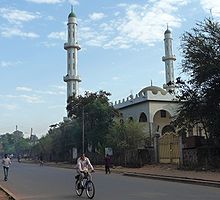 A mosque in Bahir Dar.
A mosque in Bahir Dar.
Islam in Ethiopia dates back to the founding of the religion; in 615, when a group of Muslims were counseled by Muhammad to escape persecution in Mecca and travel to Ethiopia via modern day Eritrea, which was ruled by Ashama ibn Abjar, a pious Christian king. Moreover, Bilal ibn Ribah, the first Muezzin, the person chosen to call the faithful to prayer, and one of the foremost companions of Muhammad, was from Abyssinia (Eritrea, Ethiopia etc.). Also, the largest single ethnic group of non-Arab Companions of Muhammad was that of the Ethiopians.
A small ancient group of Jews, the Beta Israel, live in northwestern Ethiopia, though most emigrated to Israel in the last decades of the 20th century as part of the rescue missions undertaken by the Israeli government, Operation Moses and Operation Solomon.[115] Some Israeli and Jewish scholars consider these Ethiopian Jews as a historical Lost Tribe of Israel.
There are numerous indigenous African religions in Ethiopia, mainly located in the far southwest and western borderlands. In general, most of the (largely members of the non-Chalcedonian Ethiopian Orthodox Tewahedo Church) Christians live in the highlands, while Muslims and adherents of traditional African religions tend to inhabit more lowland regions in the east and south of the country.
Calendar
Main article: Ethiopian calendarEthiopia has several local calendars. The most widely-known is the Ethiopian calendar, also known as the Ge'ez calendar. It is based on the older Alexandrian or Coptic calendar, which in turn derives from the Egyptian calendar. However, like the Julian calendar, the Ethiopian calendar adds a leap day every four years without exception, and begins the year on August 29 or August 30 in the Julian calendar. A seven to eight-year gap between the Ethiopian and Gregorian calendars results from alternate calculations.
Another prominent calendrical system was developed by the Oromo around 300 BCE. A lunar-stellar calendar, it relies on astronomical observations of the moon in conjunction with seven particular stars or constellations. Oromo months (stars/lunar phases) are Bittottessa (Iangulum), Camsa (Pleiades), Bufa (Aldebarran), Waxabajjii (Belletrix), Obora Gudda (Central Orion-Saiph), Obora Dikka (Sirius), Birra (full moon), Cikawa (gibbous moon), Sadasaa (quarter moon), Abrasa (large crescent), Ammaji (medium crescent), and Gurrandala (small crescent).[116]
Urbanization
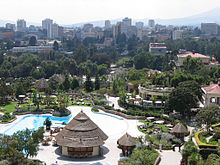 View of the capital Addis Ababa from the Sheraton Hotel.
View of the capital Addis Ababa from the Sheraton Hotel.
Population growth, migration, and urbanization are all straining both governments' and ecosystems' capacity to provide people with basic services.[117] Urbanization has steadily been increasing in Ethiopia, with two periods of significantly rapid growth. First, in 1936–1941 during the Italian occupation of Mussolini’s fascist regime, and from 1967 to 1975 when the populations of urban centers tripled.[118] In 1936, Italy annexed Ethiopia, building infrastructure to connect major cities, and a dam providing power and water.[119] This along with the influx of Italians and laborers was the major cause of rapid growth during this period. The second period of growth was from 1967 to 1975 when rural populations migrated to urban centers seeking work and better living conditions.[118] This pattern slowed after to the 1975 Land Reform program instituted by the government provided incentives for people to stay in rural areas. As people moved from rural areas to the cities, there were fewer people to grow food for the population. The Land Reform Act was meant to increase agriculture since food production was not keeping up with population growth over the period of 1970–1983.[120] This program proliferated the formation of peasant associations, large villages based on agriculture.[120] The act did lead to an increase in food production, although there is debate over the cause; it may be related to weather conditions more than the reform act.[120] Urban populations have continued to grow with an 8.1% increase from 1975 to 2000.[121]
Rural and urban life
Migration to urban areas is usually motivated by the hope of better lives. In peasant associations daily life is a struggle to survive. About 16% of the population in Ethiopia are living on less than 1 dollar per day (2008). Only 65% of rural households in Ethiopia consume the World Health Organization's minimum standard of food per day (2,200 kilocalories), with 42% of children under 5 years old being underweight.[122] Most poor families (75%) share their sleeping quarters with livestock, and 40% of children sleep on the floor, where nighttime temperatures average 5 degrees Celsius in the cold season.[122] The average family size is six or seven, living in a 30-square-meter mud and thatch hut, with less than two hectares of land to cultivate.[122] These living conditions are deplorable, but are the daily lives of peasant associations.
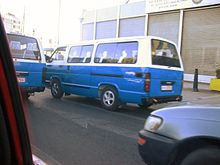 Street scene on Bole Road in Addis Ababa
Street scene on Bole Road in Addis Ababa
The peasant associations face a cycle of poverty. Since the landholdings are so small, farmers cannot allow the land to lie fallow, which reduces soil fertility.[122] This land degradation reduces the production of fodder for livestock, which causes low milk yields.[122] Since the community burns livestock manure as fuel, rather than plowing the nutrients back into the land, the crop production is reduced.[122] The low productivity of agriculture leads to inadequate incomes for farmers, hunger, malnutrition and disease. These unhealthy farmers have a hard time working the land and the productivity drops further.[122]
Although conditions are drastically better in cities, all of Ethiopia suffers from poverty, and poor sanitation. In the capital city of Addis Ababa, 55% of the population lives in slums.[119] Although there are some wealthy neighborhoods with mansions, most people make their houses using whatever materials are available, with walls made of mud or wood. Only 12% of homes have cement tiles or floors.[119] Sanitation is the most pressing need in the city, with most of the population lacking access to waste treatment facilities. This contributes to the spread of illness through unhealthy water.[119]
Despite the living conditions in the cities, the people of Addis Ababa are much better off than people living in the peasant associations owing to their educational opportunities. Unlike rural children, 69% of urban children are enrolled in primary school, and 35% of those eligible for secondary school attend.[119] Addis Ababa has its own university as well as many other secondary schools. The literacy rate is 82%.[119]
Health is also much greater in the cities. Birth rates, infant mortality rates, and death rates are lower in the city than in rural areas owing to better access to education and hospitals.[119] Life expectancy is higher at 53, compared to 48 in rural areas.[119] Despite sanitation being a problem, use of improved water sources is also greater; 81% in cities compared to 11% in rural areas.[121] This encourages more people to migrate to the cities in hopes of better living conditions.
Many NGOs (Non-Governmental Organizations) are working to solve this problem; however, most are far apart, uncoordinated, and working in isolation.[121] The Sub-Saharan Africa NGO Consortium is attempting to coordinate efforts among NGOs in Uganda, Kenya, Tanzania, Zambia, South Africa, Zimbabwe, Ethiopia, Sudan, Cameroon, the Democratic Republic of Congo, Senegal, Ivory Coast, Mali, Ghana, and Nigeria.[121]
Health
Main article: Health in EthiopiaAccording to the head of the World Bank's Global HIV/AIDS Program, Ethiopia has only 1 medical doctor per 100,000 people.[123] However, the World Health Organization's 2006 World Health Report gives a figure of 1936 physicians (for 2003),[124] which comes to about 2.6 per 100,000. Globalization is said to affect the country, with many educated professionals leaving Ethiopia for a better economic opportunity in the West.
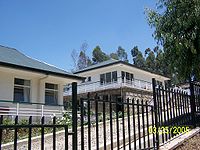 The Addis Ababa Fistula Hospital in the capital Addis Ababa.
The Addis Ababa Fistula Hospital in the capital Addis Ababa.
Ethiopia's main health problems are said to be communicable diseases caused by poor sanitation and malnutrition. These problems are exacerbated by the shortage of trained manpower and health facilities.[125]
There are 119 hospitals (12 in Addis Ababa alone) and 412 health centers in Ethiopia.[126] Ethiopia has a relatively low average life expectancy of 45 years.[127] Infant mortality rates are relatively very high, as over 8% of infants die during or shortly after childbirth,[127] (although this is a dramatic decrease from 16% in 1965) while birth-related complications such as obstetric fistula affect many of the nation's women. HIV is also prevalent in the country.
The other major health problem in Ethiopia is spread of Acquired Immune Deficiency Syndrome (AIDS). AIDS has mainly affected poor communities and women, due to lack of health education, empowerment, awareness and lack of social well being. The government of Ethiopia and many private organizations like World health Organization (WHO), and the United Nations, are launching campaigns and are working aggressively to improve Ethiopia’s health conditions and promote health awareness on AIDS and other communicable diseases (Dugassa, 2005). Many believe that sexually transmitted diseases like gonorrhea result from touching a stone after a female dog urinates on it and there is a general belief that these diseases are caused by bad spirits and supernatural causes. Others believe that eating the reproductive organs of a black goat will help expel the diseases from those same organ in their body (Kater, 2000). Ethiopia has high infant and maternal mortality rate. Only a minority of Ethiopians are born in hospitals; most of them are born in rural households. Those who are expected to give birth at home have elderly women serve as midwives assist with the delivery (Kater, 2000) The increase in infant and maternal mortality rate is believed to be due to lack of women’s involvement in household decision- making, immunization and social capital (Fantahun, Berhane, Wall, Byass, & Hogberg, 2007). On the other hand, the “WHO estimates that a majority of maternal fatalities and disabilities could be prevented if deliveries were to take place at well-equipped health centers, with adequately trained staff” (Dorman et al., 2009, p. 622).
 A man being tested for AIDS at an Ethiopian medical clinic.
A man being tested for AIDS at an Ethiopian medical clinic.
The low availability of health care professionals with modern medical training, together with lack of funds for medical services, leads to the preponderancy of less reliable traditional healers that use home-based therapies to heal common ailments. One medical practice that is commonly practiced irrespective of religion or economic status is female genital cutting (FGC) or female circumcision, a procedure by which some of a woman's external genital tissue, such as the clitoral hood, the clitoris or labia, are removed. According to a study performed by the Population Reference Bureau, Ethiopia has a prevalence rate of 81% among women ages 35 to 39 and 62 percent among women ages 15–19.[128] Ethiopia’s 2005 Demographic and Health Survey (EDHS) noted that the national prevalence rate is 74 percent among women ages 15–49.[129] The practice is almost universal in the regions of Dire Dawa, Somali and Afar; in the Oromo and Harari regions, more than 80% of girls and women undergo the procedure. FGC is least prevalent in the regions of Tigray and Gambela, where 29% and 27% of girls and women, respectively, are affected.[130] In 2004, the Ethiopian Government enacted a law against FGC. Female circumcision is a pre-marital custom mainly endemic to Northeast Africa and parts of the Near East that has its ultimate origins in Ancient Egypt.[131][132] Encouraged by women in the community, it is primarily intended to deter promiscuity and to offer protection from assault.[133] About 76% of Ethiopia's male population is also reportedly circumcised.[134]
The Government of the Federal Republic of Ethiopia is signatory to various international conventions and treaties that protect the rights of women and children. Its constitution provides for the fundamental rights and freedoms for women. There is an attempt being made to raise the social and economic status of women through eliminating all legal and customary practices, which hinder women’s equal participation in society and undermine their social status.
Education
Main article: Education in Ethiopia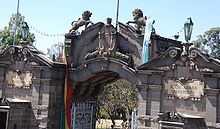 Entrance to the Addis Ababa University.
Entrance to the Addis Ababa University.
Education in Ethiopia had been dominated by the Orthodox Church for many centuries until secular education was adopted in the early 1900s.The current system follows very similar school expansion schemes to the rural areas as the previous 1980s system with an addition of deeper regionalisation giving rural education in their own languages starting at the elementary level and with more budget allocated to the education sector. The sequence of general education in Ethiopia is six years of primary school, four years of lower secondary school and two years of higher secondary school.[135] in 2004 school enrollment was below that of many other African countries.[136] Half the population of Ethiopia is illiterate.[137]
Culture
Main article: Culture of EthiopiaCuisine
 Typical Ethiopian cuisine: Injera (pancake-like bread) and several kinds of wat (stew).
Typical Ethiopian cuisine: Injera (pancake-like bread) and several kinds of wat (stew). Main article: Ethiopian cuisine
Main article: Ethiopian cuisineThe best known Ethiopian cuisine consists of various vegetable or meat side dishes and entrées, usually a wat, or thick stew, served atop injera, a large sourdough flatbread made of teff flour. One does not eat with utensils, but instead uses injera to scoop up the entrées and side dishes. Chachabsa, Marka, Chukko and Dhanga are the most popular dish among the Oromos. Kitfo being originated from Gurage is one of the widely accepted and favorite food in Ethiopia.
Tihlo prepared from roasted barley flour is very popular in Amhara, Agame, and Awlaelo (Tigrai). Traditional Ethiopian cuisine employs no pork or shellfish of any kind, as they are forbidden in the Islamic, Jewish, and Ethiopian Orthodox Christian faiths. It is also very common to eat from the same dish in the center of the table with a group of people.
Music
Main article: Music of EthiopiaThe music of Ethiopia is extremely diverse, with each of the country's 80 ethnic groups being associated with unique sounds. Ethiopian music uses a distinct modal system that is pentatonic, with characteristically long intervals between some notes. As with many other aspects of Ethiopian culture and tradition, tastes in music and lyrics are strongly linked with those in neighboring Eritrea, Somalia, Djibouti and Sudan.[138][139] Traditional singing in Ethiopia presents diverse styles of polyphony (heterophony, drone, imitation, counterpoint).
Sport
Main article: Sport in EthiopiaThe main sports in Ethiopia are athletics and football. Ethiopian athletes have won many Olympic gold medals in track and field, particularly distance running. Haile Gebrselassie is a world-renowned marathon runner, having set the world record several times. Another sportsman, Kenenisa Bekele, is also a dominant runner, particularly in the 5,000 and 10,000 meters in which he holds the world records. Other notable Ethiopian athletes are Abebe Bikila, Mamo Wolde, Miruts Yifter, Derartu Tulu, Tirunesh Dibaba, Meseret Defar, Birehane Adare, Firehiwot_Dado, and Gelete Burka.
See also
- Outline of Ethiopia
- Index of Ethiopia-related articles
- Aethiopia (Classical Greek term)
- Archaeology in Ethiopia
- Link Ethiopia
Notes
- ^ "Languages of Ethiopia". Ethnologue. Ethnologue. http://www.ethnologue.com/show_map.asp?name=ET&seq=10. Retrieved 5 September 2011.
- ^ "English". Ethnologue. Ethnologue. http://www.ethnologue.com/show_language.asp?code=eng. Retrieved 5 September 2011.
References
- ^ a b "CIA – The World Factbook – Ethiopia". Cia.gov. https://www.cia.gov/library/publications/the-world-factbook/geos/et.html. Retrieved 2009-03-16.
- ^ a b c d 2007 Census, Jimmatimes.comPDF (51.7 KB) . Retrieved 3 may 2009.
- ^ a b Embassy of Ethiopia, Washington, DC. Retrieved 6 April 2006.[dead link]
- ^ a b Central Statistical Agency of Ethiopia. Central Statistical Agency of Ethiopia
- ^ a b c d "Ethiopia". International Monetary Fund. http://www.imf.org/external/pubs/ft/weo/2011/01/weodata/weorept.aspx?pr.x=52&pr.y=2&sy=2008&ey=2011&scsm=1&ssd=1&sort=country&ds=.&br=1&c=644&s=NGDPD%2CNGDPDPC%2CPPPGDP%2CPPPPC%2CLP&grp=0&a=. Retrieved 2011-04-21.
- ^ Speaking after his signing the disputed treaty between Ethiopia and Italy in 1889, Emperor Menelik II made clear his position: "We cannot permit our integrity as a Christian and civilized nation to be questioned, nor the right to govern our empire in absolute independence. The Emperor of Ethiopia is a descendant of a dynasty that is 3,000 years old — a dynasty that during all that time has never submitted to an outsider. Ethiopia has never been conquered and she never shall be conquered by anyone." Ethiopia Unbound: Studies In Race Emancipation – p. xxv by Joseph Ephraim Casely Hayford
- ^ "Ethiopia is top choice for cradle of Homo sapiens". Nature. 16 February 2005. Archived from the original on December 15, 2007. http://web.archive.org/web/20071215171811/http://www.nature.com/news/2005/050214/full/050214-10.html. Retrieved 2008-02-02.
- ^ Li, J. Z.; Absher, DM; Tang, H; Southwick, AM; Casto, AM; Ramachandran, S; Cann, HM; Barsh, GS et al. (February 2008). "Worldwide Human Relationships Inferred from Genome-Wide Patterns of Variation". Science 319 (5866): 1100–1104. Bibcode 2008Sci...319.1100L. doi:10.1126/science.1153717. PMID 18292342. http://www.sciencemag.org/cgi/content/abstract/319/5866/1100.
- ^ "Humans Moved From Africa Across Globe, DNA Study Says". Bloomberg.com. 2008-02-21. http://www.bloomberg.com/apps/news?pid=20601081&sid=awJVkvnk8KjM&refer=australia. Retrieved 2009-03-16.
- ^ By Karen Kaplan, Los Angeles Times (2008-02-21). "Around the world from Addis Ababa". Startribune.com. http://www.startribune.com/world/15860017.html. Retrieved 2009-03-16.
- ^ Stuart Munro-Hay, Aksum: An African Civilization of Late Antiquity. Edinburgh: University Press, 1991, p. 57.
- ^ Aksumite Ethiopia
- ^ Paul B. Henze, Layers of Time: A History of Ethiopia, 2005.
- ^ United Nations Economic Commission for Africa UNECA
- ^ "The only African country with its own alphabet". Irinnews.org. http://www.irinnews.org/report.aspx?reportid=52014. Retrieved 2010-06-02.
- ^ "World Heritage List – Africa". UNESCO. http://whc.unesco.org/en/list/?search=&searchSites=&search_by_country=&search_yearinscribed=&type=&media=®ion=5&criteria_restrication=&order=. Retrieved 2009-08-06.
- ^ Paul B. Henze, Layers of Time: A History of Ethiopia, 2005.
- ^ Davison, William (2010-07-15). "Ethiopia Africa's second biggest hydropower". Bloomberg.com. http://www.bloomberg.com/news/2010-07-15/ethiopia-will-export-power-to-sudan-from-september-after-rains-boost-dams.html. Retrieved 2010-12-12.
- ^ "History of Conflict and Conservation: 1961–1991". Worldwildlife.org. 1974-09-12. http://www.worldwildlife.org/bsp/publications/africa/147/history.htm. Retrieved 2010-12-12.
- ^ "Ethiopia surpasses Kenya to become East Africa's Biggest Economy". Nazret.com. http://nazret.com/blog/index.php?title=ethiopia_surpasses_kenya_to_become_east_&more=1&c=1&tb=1&pb=1. Retrieved 2010-06-02.
- ^ No Author. "Ethiopia has fastest growing non-Oil Economy in Africa – IMF". Jimmatimes.com. http://www.jimmatimes.com/article.cfm?articleID=17566. Retrieved 2010-06-02.
- ^ "Ethiopia will be 5th fastest growing economy in the world in 2010 – economist". Export.by. 2009-11-25. http://www.export.by/en/?act=news&mode=view&id=14969. Retrieved 2010-06-02.
- ^ Ethiopia regional powerhouse[dead link]
- ^ "CSIS on Ethiopia regional power". Csis.org. 2007-01-22. http://csis.org/blog/ethiopia-and-search-regional-peace-horn-africa. Retrieved 2010-06-02.
- ^ http://grandmillenniumdam.net/ Grand Millennium Dam
- ^ Ethiopia human rights
- ^ "Ethiopia fastest growing economy". nazret.com. http://nazret.com/blog/index.php/2008/12/26/ethiopia_4th_fastest_growing_economy_in_.
- ^ Meles Zenawi summit
- ^ Histories, book 2, chapters 29 and 146; book 3 chapter 17 Odyssey, book 1, lines 22–23; book 4, line 84
- ^ Histories, II, 29–30; III, 114; IV, 197
- ^ Nat. Hist. 6.184–187; son of Hephaestus was also a general Greek epithet meaning "blacksmith".
- ^ India Sacra: hoc est suppetiae sacrae, ex vtraque India in Europam, pro ... by Francisco Colin, p.5; see also Aethiopia
- ^ "Aithiops, Henry George Liddell, Robert Scott, ''A Greek-English Lexicon'', at Perseus". Perseus.tufts.edu. http://www.perseus.tufts.edu/cgi-bin/ptext?doc=Perseus%3Atext%3A1999.04.0057%3Aentry%3D%232329. Retrieved 2009-03-16.
- ^ Anton L. Allahar. "When Black First Became Worth Less". International Journal of Comparatigve Sociology 34 (1–2). http://books.google.com/books?id=Mms33VopsQQC&lpg=PA336&dq=%22When%20Black%20First%20Became%20Worth%20Less%22&pg=PA338#v=onepage&q=burnt-faced&f=false.
- ^ Cp. Ezekiel 29:10
- ^ Acts 8:27
- ^ Munro Hay 1991
- ^ "Abyssinia – LoveToKnow 1911". 1911encyclopedia.org. 2006-10-22. http://www.1911encyclopedia.org/Abyssinia. Retrieved 2009-03-16.
- ^ White, Tim D., Asfaw, B., DeGusta, D., Gilbert, H., Richards, G.D., Suwa, G. and Howell, F.C. (2003). "Pleistocene Homo sapiens from Middle Awash, Ethiopia". Nature 423 (6491): 742–747. doi:10.1038/nature01669. PMID 12802332.
- ^ Stuart Munro-Hay, Aksum: An African Civilization of Late Antiquity. Edinburgh: University Press, 1991, pp.57.
- ^ Taddesse Tamrat, Church and State in Ethiopia: 1270–1527 (Oxford: Oxford University Press, 1972), pp. 5–13.
- ^ ibid.
- ^ Herausgegeben von Uhlig, Siegbert. Encyclopaedia Aethiopica, "Ge'ez". Wiesbaden:Harrassowitz Verlag, 2005, pp. 732.
- ^ Munro-Hay, Aksum, pp. 57.
- ^ Pankhurst, Richard K.P. Addis Tribune, "Let's Look Across the Red Sea I", 17 January 2003.
- ^ Stuart Munro-Hay, Aksum: A Civilization of Late Antiquity (Edinburgh: University Press, 1991), pp. 13.
- ^ Ian Mortimer, The Fears of Henry IV (2007), p.111
- ^ Girma Beshah and Merid Wolde Aregay, The Question of the Union of the Churches in Luso-Ethiopian Relations (1500–1632) (Lisbon: Junta de Investigações do Ultramar and Centro de Estudos Históricos Ultramarinos, 1964), pp. 13–4.
- ^ Girma and Merid, Question of the Union of the Churches, pp. 25.
- ^ Girma and Merid, Question of the Union of the Churches, pp. 45–52.
- ^ Girma and Merid, Question of the Union of the Churches, pp. 91, 97–104.
- ^ Girma and Merid, Question of the Union of the Churches, p. 105.
- ^ van Donzel, Emeri, "Fasilädäs" in Siegbert von Uhlig, ed., Encyclopaedia Aethiopica: D-Ha (Wiesbaden:Harrassowitz Verlag, 2005), p. 500.
- ^ Pankhurst, Richard, The Ethiopian Royal Chronicles, (London:Oxford University Press, 1967), pp. 139–43.
- ^ "17th century Oromo rule of Gondar". Gargaaraoromopc.org. 1996-04-23. http://gargaaraoromopc.org/OPC_Program.aspx. Retrieved 2009-03-16.[dead link]
- ^ http://vislardica.com/VisImperica/Wars/vi_egypt_abyssinia.htm
- ^ John Young. “Regionalism and Democracy in Ethiopia” Third World Quarterly, Vol. 19, No. 2 (June 1998) pp. 192
- ^ Ibid; the people subjugated and incorporated were the Oromo, Sidama, Gurage, Wolayta and other groups. International Crisis Group. “Ethiopia: Ethnic Federalism and its Discontents” Africa Report No. 153, (4 September 2009) pp. 2
- ^ Great Britain and Ethiopia 1897–1910: Competition for Empire Edward C. Keefer, International Journal of African Studies Vol. 6 No. 3 (1973) page 470
- ^ International Crisis Group “Ethnic Federalism and its Discontents” pp. 2
- ^ Tekeste Negash. Eritrea and Ethiopia : The Federal Experience. (Uppsala, Sweden: Nordiska Afrikainstitutet, 2005), 13–14.
- ^ Tekeste Negash. Eritrea and Ethiopia : The Federal Experience. (Uppsala, Sweden: Nordiska Afrikainstitutet, 2005), 14
- ^ Tekeste Negash. Eritrea and Ethiopia” pp 14 and ICG “Ethnic Federalism and its Discontents” pp 2; Italy lost over 4.600 nationals in this battle.
- ^ Famine Hunger stalks Ethiopia once again – and aid groups fear the worst. Time. December 21, 1987
- ^ Pankhurst R. The Great Ethiopian Famine of 1888–1892: A New Assessment. J Hist Med Allied Sci (1966) XXI(2): 95–124.doi: 10.1093/jhmas/XXI.2.95
- ^ Clapham, Christopher, "Ḫaylä Śəllase" in Siegbert von Uhlig, ed., Encyclopaedia Aethiopica: D-Ha (Wiesbaden:Harrassowitz Verlag, 2005), pp. 1062–3.
- ^ Monday, Jan. 06, 1936 (1936-01-06). "Man of the Year". TIME. http://www.time.com/time/magazine/article/0,9171,755559-1,00.html. Retrieved 2009-03-16.
- ^ Clapham, "Ḫaylä Śəllase", Encyclopaedia Aethiopica, p. 1063.
- ^ "Ethiopia" (PDF). http://www.globalmarch.org/resourcecentre/world/ethiopia.pdf. Retrieved 2010-06-02.
- ^ "Chronology of slavery". MertSahinoglu.com. 1994-02-23. http://mertsahinoglu.com/research/chronology-of-slavery/. Retrieved 2009-09-29.
- ^ "Women and Slavery: Africa, the Indian Ocean world, and the medieval north Atlantic". Gwyn Campbell, Suzanne Miers, Joseph Calder Miller (2007). Ohio University Press. p.219. ISBN 0-8214-1724-X
- ^ a b Black Book of Communism p. 687–695
- ^ Dagne, Haile Gabriel (2006). The commitment of the German Democratic Republic in Ethiopia: a study based on Ethiopian sources. Münster, London: Lit; Global. ISBN 9783825895358.
- ^ US admits helping Mengistu escape BBC, 22 December 1999
- ^ "Mengistu found guilty of genocide". BBC. 12 December 2006. http://news.bbc.co.uk/2/hi/africa/6171429.stm. Retrieved 2007-07-21. "Ethiopia's Marxist ex-ruler, Mengistu Haile Mariam, has been found guilty of genocide after a 12-year trial."
- ^ Will arms ban slow war? BBC 18 May 2000
- ^ "The worst drought in 60 years in Horn Africa". Africa and Europe in Partnership. http://www.africa-eu-partnership.org/node/2158. Retrieved 2 August 2011.
- ^ Constitution of Ethiopia – 8 December 1994
- ^ The Economist Intelligence Unit's Index of Democracy 2010
- ^ a b c "Map of Freedom 2007". Freedom House. http://freedomhouse.org/template.cfm?page=22&year=2007&country=7175. Retrieved 2007-12-25.
- ^ a b "Essential Background: Overview of human rights issues in Ethiopia". Human Rights Watch. http://hrw.org/englishwr2k7/docs/2007/01/11/ethiop14704.htm. Retrieved 2007-12-25.
- ^ "Ethiopian probe team criticises judge over report.". Reuters. http://today.reuters.co.uk/news/CrisesArticle.aspx?storyId=L07807962&WTmodLoc=World-R5-Alertnet-2. Retrieved 2007-07-21.[dead link]
- ^ "CIA World Factbook -Rank Order – Area". https://www.cia.gov/library/publications/the-world-factbook/rankorder/2147rank.html. Retrieved 2008-02-02.
- ^ a b Massicot, Paul (2005). Animal Info-Ethiopia. Retrieved 24 May 2008, from Animalinfo.org.
- ^ Bakerova, Katarina et al. (1991) Wildlife Parks Animals Africa. Retrieved 24 May 2008, from the African Cultural Center.
- ^ Encyclopedia of Nations. Ethiopia Environment. Retrieved on 24 May 2008, from the Encyclopedia of the Nationsencyclopedia.com website
- ^ Kurpis, Lauren (2002). How to Help Endangered Species. Retrieved 25 May 2008, from the Endageredspecie.com website.
- ^ (IUCN Red List of Threatened Animals)
- ^ Mongabay.com Ethiopia statistics. (n.d). Retrieved 18 November 2006, from Rainforests.mongabay.com
- ^ Parry, J (2003). Tree choppers become tree planters. Appropriate Technology, 30(4), 38–39. Retrieved 22 November 2006, from ABI/INFORM Global database. (Document ID: 538367341).
- ^ "Ethiopia sees Africa's fastest growth". Afrol.com. http://www.afrol.com/articles/28991. Retrieved 2009-03-16.
- ^ "Six million children threatened by Ethiopia drought: UN". Terradaily.com. http://www.terradaily.com/reports/Six_million_children_threatened_by_Ethiopia_drought_UN_999.html. Retrieved 2009-03-16.
- ^ "Water tower of east africa". BBC News. 2004-01-09. http://news.bbc.co.uk/2/hi/programmes/this_world/3359367.stm. Retrieved 2010-06-02.
- ^ Giorgis, Tamrat G. (2007-01-27). "IMF Positive on Ethiopia’s Growth Outlook". Addis Fortune. Archived from the original on February 23, 2008. http://web.archive.org/web/20080223234045/http://www.addisfortune.com/IMF+Positive+on+Ethiopia%92s+Growth+Outlook.htm. Retrieved 2008-02-02.
- ^ "Ethiopia has fastest growing African economy that is not Oil dependent". Jimma Times. 2008-01-09. http://www.jimmatimes.com/article.cfm?articleID=17566. Retrieved 2008-02-02.
- ^ "Get the gangsters out of the food chain". The Economist. 2007-06-07. http://www.economist.com/world/africa/displaystory.cfm?story_id=9304411. Retrieved 2008-02-02.
- ^ "Starbucks in Ethiopia coffee vow". BBC. 21 June 2007. http://news.bbc.co.uk/1/hi/business/6225514.stm. Retrieved 2007-06-21. "Starbucks has agreed a wide-ranging accord with Ethiopia to support and promote its coffee, ending a long-running dispute over the issue. ... Ethiopia is Africa's largest coffee producer, ahead of Uganda and the Ivory Coast, and coffee is its largest source of foreign exchange."
- ^ "Ethiopia's flower trade in full bloom". Mail & Guardian. 19 February 2006. http://www.mg.co.za/articlePage.aspx?articleid=264689&area=/breaking_news/breaking_news__business/. Retrieved 2007-06-21. "Floriculture has become a flourishing business in Ethiopia in the past five years, with the industry's exports earnings set to grow to $100-million by 2007, a five-fold increase on the $20-million earned in 2005. Ethiopian flower exports could generate an estimated $300-million within two to three years, according to the head of the government export-promotion department, Melaku Legesse."
- ^ page 49 The Economist May 22, 2010
- ^ a b c d Pavanello, Sara 2010. Working across borders – Harnessing the potential of cross-border activities to improve livelihood security in the Horn of Africa drylands. London: Overseas Development Institute
- ^ Averill, Victoria (2007-05-31). "Ethiopia's designs on leather trade". BBC. http://news.bbc.co.uk/2/hi/business/6703551.stm. Retrieved 2007-06-21. "The label inside the luxuriously soft black leather handbag reads Taytu: Made In Ethiopia. But the embroidered print on the outside, the chunky bronze rings attached to the fashionably short straps and the oversized "it" bag status all scream designer chic."
- ^ "Largest hydro electric power plant goes smoothly". English.people.com.cn. 2006-04-12. http://english.people.com.cn/200604/12/eng20060412_257767.html. Retrieved 2010-06-02.
- ^ "Hydroelectric Power Plant built". Addistribune.com. http://www.addistribune.com/Archives/2004/02/27-02-04/New.htm. Retrieved 2009-03-16.
- ^ Foek, Anton (2007-05-16). "new coffee deal with Starbucks". Alternet.org. http://www.alternet.org/story/51936/. Retrieved 2009-03-16.
- ^ Ethiopia water resources referred as "White oil"[dead link]
- ^ Independent Online. "Ethiopia hopes to power neighbours with dams". Int.iol.co.za. http://www.int.iol.co.za/index.php?set_id=1&click_id=87&art_id=qw1145360700509B231. Retrieved 2009-03-16.
- ^ "Sub-Saharan Africa news in brief: 13–25 March". SciDev.Net. 2008-03-28. http://www.scidev.net/en/sub-suharan-africa/news/sub-saharan-africa-news-in-brief-13-25-march.html. Retrieved 2009-03-16.
- ^ a b CO2 Emissions from Fuel Combustion Population 1971–2008 IEA (pdf pages 83–85
- ^ Diercke Landerlexicon, 1983
- ^ "The Economics of the Indian Ocean slave trade in the nineteenth century". W. G. Clarence-Smith (1989). p.100. ISBN 0-7146-3359-3
- ^ "— About us". Abesha.com. http://www.abesha.com/abesha18/aboutus.php. Retrieved 2009-03-16.
- ^ Time Europe — Abyssinia: Ethiopian Protest[dead link] 9 August 1926
- ^ "World Refugee Survey 2008". U.S. Committee for Refugees and Immigrants. 2008-06-19. http://www.refugees.org/survey.
- ^ Ethnologue - Languages of Ethiopia
- ^ "The History of Ethiopian Jews". Jewishvirtuallibrary.org. http://www.jewishvirtuallibrary.org/jsource/Judaism/ejhist.html. Retrieved 2009-03-16.
- ^ Doyle, Lawrence R. "The Borana Calendar Reinterpreted". http://www.tusker.com/Archaeo/art.currentanthro.htm.
- ^ Racin, L. "Future Shock: How Environmental Change and Human Impact Are Changing the Global Map" Woodrow Wilson International Center for Scholars, 2008. Wilsoncenter.org
- ^ a b Ofcansky, T and Berry, L. "Ethiopia: A Country Study". Editied by Washington: GPO for the Library of Congress, 1991. Countrystudies.us
- ^ a b c d e f g h Shivley, K. "Addis Ababa, Ethiopia" Macalester.edu, Accessed 15 May 2008.
- ^ a b c Anderson, Frank. Belete, Abenet, Dillon, John L. "Development of Agriculture in Ethiopia since the 1975 land reform" Agricultural Economics. Blackwell. 2 December 1991. Pages 159–175
- ^ a b c d Worldbank.org, Accessed 5-10-08[not specific enough to verify]
- ^ a b c d e f g Crawley, Mike. "Breaking the Cycle of Poverty in Ethiopia". April, 2003. International Development Research Centre. Retrieved on 24 May 2008, from the IDRC website. Idl-bnc.idrc.ca
- ^ BBC, The World Today, 24 July 2007
- ^ "Global distribution of health workers in WHO Member States" (PDF). The World Health Report 2006. World Health Organization. http://www.who.int/whr/2006/annex/06_annex4_en.pdf. Retrieved 2008-02-02.
- ^ "Ethiopia – Health and Welfare". Countrystudies.us. http://countrystudies.us/ethiopia/75.htm. Retrieved 2009-03-16.
- ^ "Ethiopia" (PDF). Archived from the original on June 24, 2008. http://web.archive.org/web/20080624223842/http://www.etharc.org/publications/june2005whoestimate_eth.pdf. Retrieved 2010-06-02.[dead link]
- ^ a b Aids Action (The International News Letter on AIDS Prevention and Care): Issue 46, Health Link World Wide (October–December 1999)
- ^ Fedman-Jacobs and Clifton, Female Geintal Mutilation/Cutting:Data and Trends-Update 2010, http://www.prb.org/Publications/Datasheets/2010/fgm2010.aspx.
- ^ Ethiopian Demographic and Health Survey (Central Statistics Agency, 2005), p. 1.
- ^ "Female Genital Mutilation in Ethiopia", Africa Department, 2007.
- ^ Rose Oldfield Hayes (November 1975). "Female genital mutilation, fertility control, women's roles, and the patrilineage in modern Sudan: a functional analysis". American Ethnologist 2 (4): 617–633. doi:10.1525/ae.1975.2.4.02a00030.
- ^ Herbert L. Bodman, Nayereh Esfahlani Tohidi, Women in Muslim societies: diversity within unity, (Lynne Rienner Publishers: 1998), p. 41.
- ^ Suzanne G. Frayser, Thomas J. Whitby, Studies in human sexuality: a selected guide, (Libraries Unlimited: 1995), p. 257.
- ^ "Male Circumcision and AIDS: The Macroeconomic Impact of a Health Crisis by Eric Werker, Amrita Ahuja, and Brian Wendell :: NEUDC 2007 Papers :: Northeast Universities Development Consortium Conference" (PDF). Center for International Development at Harvard University. http://www.cid.harvard.edu/neudc07/docs/neudc07_s1_p02_ahuja.pdf. Retrieved 2010-12-30.
- ^ Damtew Teferra and Philip. G. Altbach, eds., African Higher Education: An International Reference Handbook Indiana University Press, 2003, pp. 316–325
- ^ "Ethiopia" (PDF). http://www.ibe.unesco.org/International/ICE47/English/Natreps/reports/ethiopia_scan.pdf. Retrieved 2009-12-30.
- ^ "Globalis – an interactive world map – Ethiopia – Adult illiteracy". Globalis.gvu.unu.edu. http://globalis.gvu.unu.edu/indicator_detail.cfm?country=ET&indicatorid=27. Retrieved 2009-12-30.
- ^ Abdullahi, Mohamed Diriye (2001). Culture and customs of Somalia. Greenwood Publishing Group. pp. 170. ISBN 0313313334. http://books.google.ca/books?id=2Nu918tYMB8C&pg=PA170#v=onepage&q&f=false. ""Somali music, a unique kind of music that might be mistaken at first for music from nearby countries such as Ethiopia, the Sudan, or even Arabia, can be recognized by its own tunes and styles.""
- ^ Tekle, Amare (1994). Eritrea and Ethiopia: from conflict to cooperation. The Red Sea Press. pp. 197. ISBN 0932415970. http://books.google.com/books?id=xbQTEF0rd7wC&pg=PA197#v=onepage&q&f=false. ""Djibouti, Eritrea, Ethiopia, Somalia and Sudan have significant similarities emanating not only from culture, religion, traditions, history and aspirations[...] They appreciate similar foods and spices, beverages and sweets, fabrics and tapestry, lyrics and music, and jewelry and fragrances.""
Further reading
- Zewde, Bahru (2001). A History of Modern Ethiopia, 1855–1991. 2nd ed. Athens, OH: Ohio University Press. ISBN 0821414402.
- Selassie I., Haile (1999). My Life and Ethiopia's Progress: The Autobiography of Emperor Haile Selassie I. Translated by Edward Ullendorff. Chicago: Frontline. ISBN 0948390409.
- Henze, Paul B. (2004). Layers of Time: A History of Ethiopia. Shama Books. ISBN 1-931253-28-5.
- Marcus, Harold G. (1975). The Life and Times of Menelik II: Ethiopia, 1844–1913. Oxford, U.K.: Clarendon. Reprint, Trenton, NJ: Red Sea, 1995. ISBN 1-56902-009-4.
- Marcus, Harold G. (2002). A History of Ethiopia (updated ed.). Berkeley: University of California Press. ISBN 0520224795.
- Mockler, Anthony (1984). Haile Selassie's War. New York: Random House. Reprint, New York: Olive Branch, 2003. ISBN 1-902669-53-3.
- Pankhurst, Richard. "History of Northern Ethiopia — and the Establishment of the Italian Colony or Eritrea". Civic Webs Virtual Library. http://www.civicwebs.com/cwvlib/africa/ethiopia/pankhurst/history_of_northern_ethiopia.htm. Retrieved 5 April 2008.
- Rubenson, Sven (2003). The Survival of Ethiopian Independence (4th ed.). Hollywood, CA: Tsehai. ISBN 0972317279.
- Siegbert Uhlig, et al. (eds.) (2003). Encyclopaedia aethiopica, Vol. 1: A-C. Wiesbaden: Harrassowitz Verlag.
- Siegbert Uhlig, et al. (eds.) (2005). Encyclopaedia aethiopica, Vol. 2: D-Ha. Wiesbaden: Harrassowitz Verlag.
- Siegbert Uhlig, et al. (eds.) (2007). Encyclopaedia aethiopica, Vol. 3: He-N. Wiesbaden: Harrassowitz Verlag.
- Arnaldo Mauri, The Early Development of Banking in Ethiopia, International Review of Economics, Vol. L, n. 4, 2003, pp. 521–543.
- Arnaldo Mauri, The re-establishment of the national monetary and banking system in Ethiopia, 1941–1964, The South African Journal of Economic History, 24 (2), 2009, pp. 82–131.
 This article incorporates public domain material from websites or documents of the Library of Congress Country Studies.
This article incorporates public domain material from websites or documents of the Library of Congress Country Studies. This article incorporates public domain material from websites or documents of the CIA World Factbook.
This article incorporates public domain material from websites or documents of the CIA World Factbook.
External links
 News related to Category:Ethiopia at Wikinews
News related to Category:Ethiopia at Wikinews
Ethiopia entry at The World Factbook
- Ethiopian Tourism Commission Ethiopian Ministry of Culture and Tourism
- BBC Ethiopia Profile
- Kebra Negast Kebra Negast | History and Culture
- Ethiopia at the Open Directory Project
- Wikimedia Atlas of Ethiopia
- Ethiopia travel guide from Wikitravel
- nazret.com Nazret Ethiopian news portal
- Ethiopian News Agency Government news agency
Links to related articles  Ethiopia topics
Ethiopia topicsRegions History Demographic · Economic · Military
Timeline · Early · Kingdom of Dʿmt · Kingdom of Aksum · Zagwe Dynasty · Abyssinian-Adal War · Zemene Mesafint · Second Italo-Abyssinian War · East African Campaign · Derg · Ethiopian Civil War · Ogaden WarEconomy History · Transport · Communications · Agriculture · Energy · Foreign aid · Industrial development · Land reform · Manufacturing · Trade Unions · Companies · Ethiopian Birr · Banks · Taxation · International rankingsPolitics · Military Constitution (history) · President · Prime Minister · Foreign relations · Foreign Aid · Ethiopian National Defense Force · Ethiopian Air Force · Ethiopian Navy · Military history · Human rights · LGBT rightsGeography
DemographicsCulture Art · Cuisine · Education · Ethiopian Christianity · Literature · Media · Music · Public Holidays · SportInternational membership Member states of the African Union (AU) Algeria · Angola · Benin · Botswana · Burkina Faso · Burundi · Cameroon · Cape Verde · Central African Republic · Chad · Comoros · Democratic Republic of the Congo · Republic of the Congo · Côte d'Ivoire · Djibouti · Egypt · Equatorial Guinea · Eritrea · Ethiopia · Gabon · The Gambia · Ghana · Guinea · Guinea-Bissau · Kenya · Lesotho · Liberia · Libya · Madagascar · Malawi · Mali · Mauritania · Mauritius · Mozambique · Namibia · Niger · Nigeria · Rwanda · Sahrawi Arab Democratic Republic · São Tomé and Príncipe · Senegal · Seychelles · Sierra Leone · Somalia · South Africa · South Sudan · Sudan · Swaziland · Tanzania · Togo · Tunisia · Uganda · Zambia · Zimbabwe
Languages Categories:- Ethiopia
- African countries
- Member states of the African Union
- Federal republics
- Former empires
- Horn of Africa
- Landlocked countries
- Least developed countries
- Member states of the United Nations
- Outline of Ethiopia
Wikimedia Foundation. 2010.

